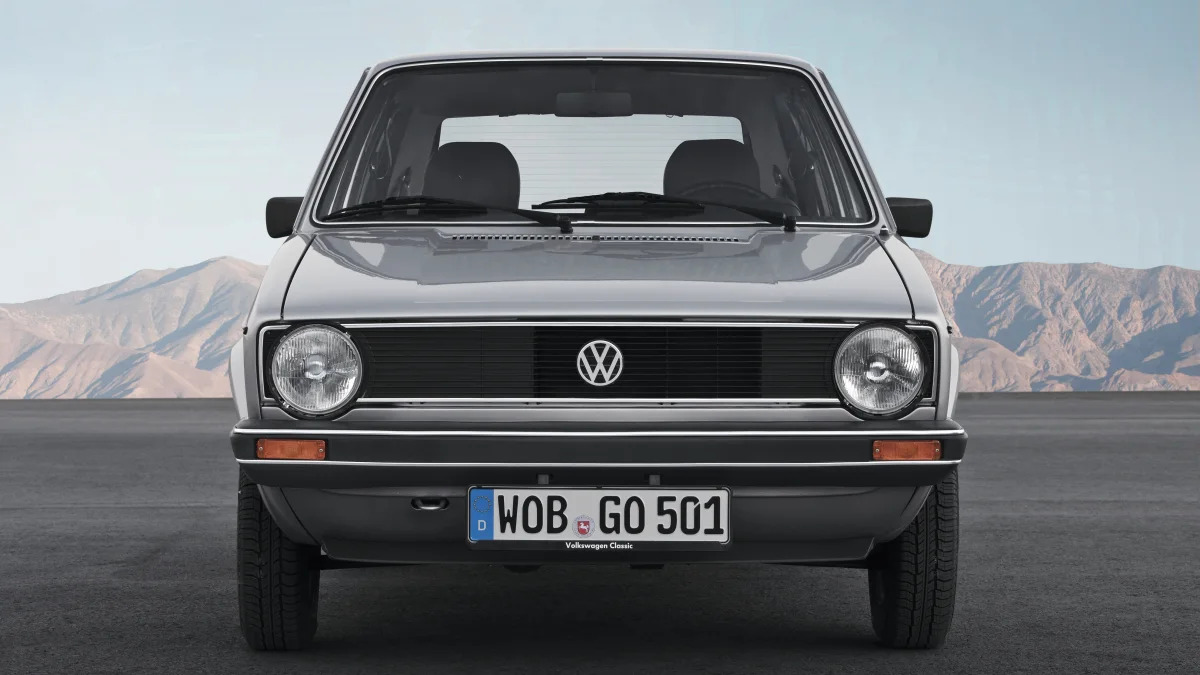Replacing the venerable Beetle was a daunting task for Volkswagen. The brand experimented with dozens of prototypes, many different drivetrain layouts, and numerous approaches to design ranging from evolutionary to revolutionary. The end result was the first Golf, which entered production in Wolfsburg, Germany, on March 29, 1974. In hindsight, the little hatchback was exactly the right car at the right time.
The shift from the Beetle to the Golf was seismic; the Golf's four-cylinder engine was transversally mounted up front and water-cooled. It was light-years ahead of its predecessor in terms of ergonomics thanks to a relatively spacious interior, a usable trunk and a hatch, and its boxy, Giugiaro-penned silhouette brought it in line with the design trends of the 1970s. And yet, the Golf didn't squash the Beetle: the Beetle lived on in some European markets into the 1980s, and it remained in continuous production with minor changes in Puebla, Mexico, until 2003.
Volkswagen didn't set the template for the city car as we know it today. Lesser-known models, such as the Autobianchi Primula (1964) and the Simca 1100 (1967), offered a transversally-mounted engine and a practical hatch before executives gave the Golf the proverbial green light for production. The brand deserves credit for improving and popularizing the concept, however. Similarly, Volkswagen didn't invent the hot hatch: Autobianchi's A112 Abarth ticked both the "hot" and the "hatch" boxes when it came out in 1971, about two years after the regular A112. With that said, the original Golf GTI helped democratize the idea that a humble economy car could also go like hell around a track.
Golf deliveries began in July 1974, and Volkswagen quickly expanded the range. Beyond the aforementioned GTI, which made its debut in 1976, the lineup grew to include a diesel-powered model launched that same year, a two-door convertible launched in 1979, and the sporty GTD variant launched in 1982. Motorists quickly took notice; Volkswagen built the 1 millionth first-generation Golf in October 1976. While the hatchback body style sold extremely well in most European markets, the Golf also spawned the Jetta for those who preferred a sedan.
America got the Golf without getting the Golf. Sales in the United States started for the 1975 model year, but Volkswagen gave the Beetle's successor the Rabbit nameplate. At launch, buyers could choose a two-door hatchback or a four-door hatchback. Power initially came from a 1.5-liter four-cylinder engine rated at 70 horsepower and 81 pound-feet of torque, though the 1976 model year brought a 1.6-liter four. The 1975 Rabbit carried a base price of $3,330, compared to $2,999 for a base Beetle (these figures represent around $19,300 and $17,300, respectively, in 2024). Rabbit production in Westmoreland, Pennsylvania, began in 1978, and it was turned into a small pickup called Caddy.
The second-generation Golf took the torch in 1983. It stood out from its predecessor with a comprehensively updated design, but it remained instantly recognizable as a Golf. Volkswagen sold an even broader range of models this time around: it notably offered four-wheel-drive (called Syncro) for the first time in 1986, launched a homologation special called Rallye in 1989, and collaborated with Steyr-Daimler-Puch to create the off-road-ready Country in 1990. The second-generation Golf hogged the spotlight, both in Volkswagen showrooms and on the new-car market, but its predecessor wasn't ready to call it a day yet. It stayed in production as the Citi Golf in South Africa until 2009.
Fast-forward to 2024, and the Golf is well into its eighth generation. Volkswagen has built roughly 37 million units of the Golf since March 29, 1974, and its historic Wolfsburg plant has produced about 20 million of those. The model has been one of Europe's best-sellers for decades.
Like the Beetle, the Golf gradually transcended its status as a form of transportation and earned a spot in popular culture. In Europe, nearly everyone has a Golf-related story. I can tell you some of mine: One of my earliest memories is my aunt picking up my family from a train station in her light-blue second-generation diesel model. I was 3 years old. About 30 years later, and after over a decade of dabbling in air-cooled Volkswagens, I became a Golf owner for the first time when I purchased a non-running 1990 CL two-door model as a project car.
Happy birthday, Golf!














Sign in to post
Please sign in to leave a comment.
Continue